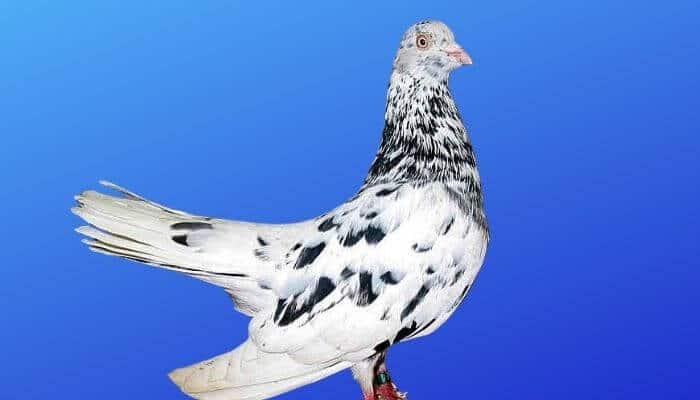The Oriental Roller is from the family of roller pigeons.
These are named for their ability to “roll” (somersault) in the air and are produced through selective breeding.

The most common roller pigeon is the Birmingham Roller.
Oriental Roller Origins
The Oriental Roller pigeon is a domestic fancy pigeon that was popularised in the United Kingdom.
However, it is a descendant of the rock pigeon and is believed to have originated in parts of Asia and the Middle East.
The Oriental Roller is also called the flying Oriental Roller and the Turkish Oriental Roller.
Though popular enough in the 1800s in the United Kingdom, the breed was developed into the Birmingham Roller Pigeon in the 1870s.
The earliest mentions of this bird are in Persian manuscripts of the twelfth century.
Oriental Roller Pigeon Appearance
An Oriental Roller is a little larger than a Birmingham Roller. It has a distinctive look where it carries it wings below its upturned tail.
The tail also has around 14 to 16 feathers, where most pigeons have around 12 tail feathers. Expect your bird to grow without around 32cm and 34cm in height, and most mature birds have a bodyweight of around 280g to 400 grams.
You may seem some of your Oriental Roller birds shake their neck. This is a natural mannerism, though it is a recessive trait, so it isn’t all that common.
In general, the Oriental Roller as a show pigeon is now accepted in all colors in the USA, but originally, they were only shown if they were black, white, and/or almond.
Oriental Roller pigeons are patterned, check or mixed, often with an abundance of kite or bronze colors. Orientals have a dilution factor that allows yellow, silver and buff colors to appear.
Their Flying Patterns
A roller’s aerial acrobatics are believed to be natural instincts in what some assume is a defence against hawks.
Though the Oriental performs similar somersaults in flight to other rollers, they also do other twists and various aerial moves.
They do not like to fly together as much as the Birmingham Roller.
Instead, they like to fly with friends, but will do their own thing in the air and take a more individualistic flying pattern.
These could be one of the oldest rolling breeds, and despite what it says on some sites online, they do fly in kits if given the chance.
The Oriental Roller’s Lack of an Oil Gland
One of the more interesting facts about this pigeon is that, similar to Amazonian parrots, and a minority of other pigeons and doves, the Oriental Roller has no uropygial gland, which is a bilobed gland located at the base of the tail of most psittacine birds.
The oil drains down into a papilla, which expresses a clear oily fluid that birds use while preening.
It keeps feathers well maintained, it makes them more waterproof and even has antibacterial and anti-fungal components.
The lack of this gland leaves the bird more susceptible to harsh environments where parasites and certain bacteria may damage their feathers.
However, to make up for the lack of an oil gland, the bird has oil quills in its plumage.
This means that if the bird gets plenty of outdoor exercise, it can maintain its feathers perhaps better than most other pigeon breeds.
But it is not recommended that you allow your bird into harsh or parasite rich biomes.
Breeding the Oriental Roller
The most important thing is to make sure that you have a pure Oriental Roller, and if you are breeding crossbreeds, then try to mix up two crossbreeds for a more interesting variety of colors and shapes.
Allowing your birds to fly in the open air and get lots of exercise often helps the birds socialize and build a relationship, which makes breeding a little more efficient in the long run, though it depends on how you exercise your pigeons.
Breeding Oriental Roller pigeons is not that different to breeding other pigeons.
Do the usual thing of overfeeding them a little on the big day, firstly so that they are concentrating on mating, and secondly because they may not eat properly if they are too distracted with each other.
Keep your pigeon areas clean, but not spotless (that is, there is no need to scrub out the corners every time).
Maintaining good hygiene is best for younger birds because a weakened immune system in a bird’s earlier years makes it more likely you will have a sickly or easily ill bird in later life.
Character
The bird sometimes flies in a very nervous and darting manner, but that doesn’t mean the bird is nervous by nature.
If your bird is normalized with humans, other birds, and the wide outdoors, then most consider the Oriental Roller to be a very confident and human-friendly bird.
It is the bird’s confidence that makes it a suitable candidate for training, such as training it to fly in a group or on its own.
Sources:
